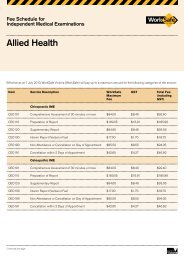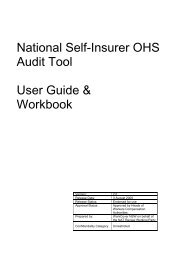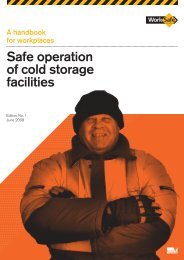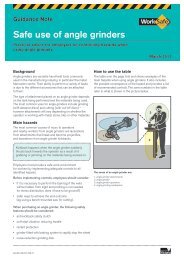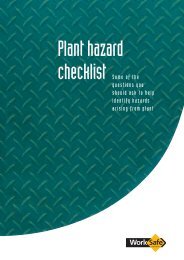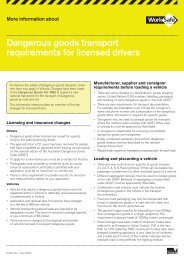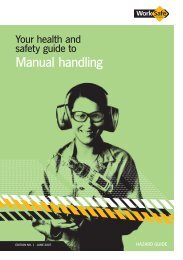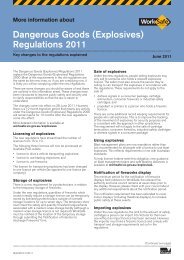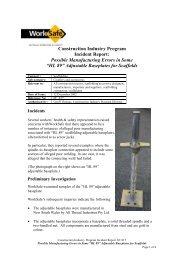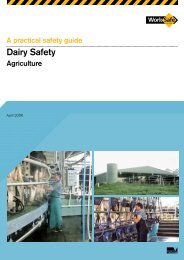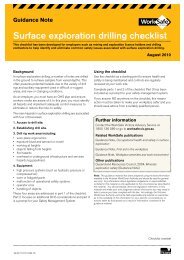Machinery and Equipment Safety - An Introduction - WorkSafe Victoria
Machinery and Equipment Safety - An Introduction - WorkSafe Victoria
Machinery and Equipment Safety - An Introduction - WorkSafe Victoria
You also want an ePaper? Increase the reach of your titles
YUMPU automatically turns print PDFs into web optimized ePapers that Google loves.
RISK CONTROL OF MACHINERY<br />
AND EQUIPMENT HAZARDS<br />
Lock out–tag out: Removing <strong>and</strong> controlling energy sources during access<br />
People performing tasks such as maintenance, repair, installation, service <strong>and</strong><br />
cleaning are highly vulnerable, <strong>and</strong> have a higher risk of being killed or maimed<br />
through inadvertent operation of machinery <strong>and</strong> equipment they are working in,<br />
on or around.<br />
Accidental start-up or movement of a machine mechanism can occur if control<br />
levers or buttons are bumped or knocked, if a short circuit of the control system<br />
occurs, when hydraulic or air pressure is released, or when undoing retaining bolts.<br />
It is essential that people who work in, on or around machinery <strong>and</strong> equipment are<br />
not exposed to hazards due to accidental start-up or movement of the mechanism.<br />
(Reference: Australian St<strong>and</strong>ard AS 4024.1603 <strong>Safety</strong> of <strong>Machinery</strong>.)<br />
The following is an overview of the lock out–tag out process:<br />
• shut-down the machinery <strong>and</strong> equipment<br />
• identify all energy sources <strong>and</strong> other hazards<br />
• identify all isolation points<br />
• isolate all energy sources<br />
• de-energise all stored energies<br />
• lock out all isolation points<br />
• tag machinery controls, energy sources <strong>and</strong> other hazards<br />
• test by ‘trying’ to reactivate the plant without exposing the tester or others<br />
to risk (failure to reactivate ensures that isolation procedures are effective<br />
<strong>and</strong> all stored energies have been dissipated).<br />
Identifying energy sources<br />
All energy sources likely to activate the machinery <strong>and</strong> equipment <strong>and</strong> expose<br />
people to hazards should be identified prior to work beginning.<br />
Such energy sources include:<br />
• electricity (mains)<br />
• battery or capacitor banks<br />
• fuels<br />
• heat<br />
• steam<br />
• fluids or gases under pressure (water, air steam or hydraulic oil)<br />
• stored energy<br />
• gravity<br />
• radiation.<br />
If original designer <strong>and</strong> installer ‘as built’ diagrams of machinery <strong>and</strong> equipment<br />
installations are not available, new diagrams <strong>and</strong> photographs showing location<br />
<strong>and</strong> details of various isolation points of machinery <strong>and</strong> equipment should be<br />
developed as part of the isolation procedures. Isolation points may include<br />
switches, valves, energy lines, pipes, power sources.<br />
These diagrams <strong>and</strong> photographs can then be used, along with written<br />
procedures, for information <strong>and</strong> training.<br />
WORKSAFE VICTORIA / MACHINERY AND EQUIPMENT SAFETY – AN INTRODUCTION 15




